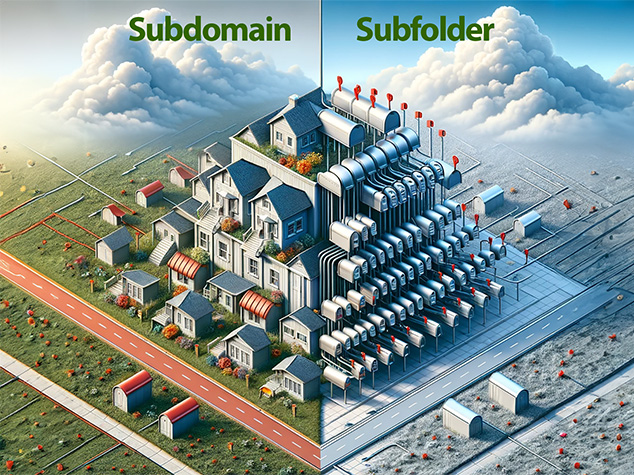- What’s a Domain Name?
- What’s a Subdomain?
- What is a Subfolder?
- Advantages of a Subdomain
- Advantages of Subfolders
- Next Steps
- FAQ: What is a Subdomain?
You may want a subdomain someday. Maybe several.
While you could use subfolders (subdirectories) instead, subdomains have certain advantages.
But how can you decide what’s best for you if you don’t know the difference?
You can’t. That’s why I’m here to help.
We’ll look at what a subdomain is, why you might use one instead of a subfolder, and why subdomains and subfolders each have specific characteristics you may need someday.
Let’s get started with the basics.
What’s a Domain Name?
By typing a domain name into your browser, you are directed to a computer server on the internet. Domain names are human-friendly links to a server’s numerical internet address (IP number).
Domain names look like this: example.com, example.org, example.net, example.gov.
What’s a Subdomain?
A subdomain is a prefix to a domain name.
Subdomains look like this: blog.example.com, store.example.org, news.example.net, support.example.gov.
By adding a subdomain, you are adding another server—another website— to your domain. This means that the content of the subdomain can be entirely different from your primary site. This is an advantage we’ll discuss in a moment.
You may add as many subfolders to a domain as you need.
Like domain names, subdomains are labeled any way you wish. You don’t need to label your blog “blog.example.com.” Name it anything you want. If you name your blog Fred, you can use the subdomain “fred.example.com.” It’s still a fully functioning blog. No worries.
One advantage to this is that you don’t have to keep your resources and programming together to have a blog or a store in addition to your primary informational or sales domain. All the technical and content details remain separate.
What is a Subfolder?
You should know that there is an alternative to having a subdomain with all your resources and programming separate.
This alternative is called a subfolder.
Subfolders look like this: example.com/blog/, example.net/store/.
You can use a subfolder for the same purpose as a subdomain. You might want to do this if you have a small site or want to keep all your resources and programming available in the same domain.
This is a strategic decision: separation (subdomain) or unity (subfolder).
The function of your domain will typically inform your choice of using a subdomain or subfolder. A web developer can assist you with this decision.
I’ll list some comparative advantages of each approach below.
Advantages of a Subdomain
Subdomains help organize your website. They assist in optimizing SEO, creating a great user experience, and efficiently managing content and functionality. They are also scalable.
The following advantages should be considered when making your strategic decision.
Organization and Structure
Subdomains create distinct sections within your site for different purposes or content types. Your website is easier to navigate and manage.
SEO Benefits
Search engines treat subdomains as separate entities, allowing you to target specific keywords or market niches more effectively.
Dedicated Functionality
Host different technologies or platforms on your website, such as a blog, forum, or e-commerce store, without affecting the performance and security of your main site.
Localization and Internationalization
Subdomains are useful for creating region-specific versions of your site. Use localized content and language to serve international audiences better.
Testing Environments
Use subdomains to set up a development or staging environment. This makes testing new features, designs, or content easier without impacting your live primary site.
Branding and Marketing
Launching new products, campaigns, or landing pages on separate subdomains helps focus your marketing efforts and track their performance more effectively. You can change the visual branding as needed.
Increased Security
You enhance your website’s security by isolating different applications or services on subdomains. Issues in one part of your site are less likely to affect the rest.
Flexibility and Scalability
As your business grows, subdomains offer the flexibility to scale your online presence. Add new services or content areas without completely overhauling your main site. This saves time and money.
Advantages of Subfolders
Subfolders have their benefits, too.
- Keep content more closely integrated with the main website (e.g., example.com/blog) by using subfolders. This is useful for maintaining cohesive site navigation and consolidating domain authority.
- Subfolders benefit from the main domain’s existing SEO architecture, consolidating ranking power in a single domain. This is often preferred for SEO unless there’s a strategic need for content separation.
- With subfolders, all content resides on the same server and shares the same security environment. This simplifies management and ensures better consistency, especially when updating.
- Subfolders contribute to a unified brand experience. Businesses typically emphasize a singular brand image and cohesive user journey across all content. Maintenance, updates, and upgrades are simpler when resources and programming are available across subfolders.
- It’s usually easier to set up and manage subfolders for smaller sites or those without the need for significant segmentation of content or services.
Next Steps
The strategic decision is yours. You know the difference between a subdomain and a subfolder. You can choose whichever will better benefit your overall web plans.
Still, you may have questions. If so, please visit Tiiny.host/help/.
Our excellent support staff will gladly answer your questions about subdomains, subfolders, hosting, or any internet topic. You don’t even need an account with us to have a chat. Or an email.
Tiiny.host offers fully-automated web hosting and advanced features. Host a static website, PDF, or other digital resource for free on our entry-level tier.
Visit Tiiny.host for free today.
FAQ: What is a Subdomain?
Are subdomains considered separate websites by search engines?
Search engines can view subdomains as separate entities from the main domain, which means they can be indexed and ranked independently in search results.
How do I decide between a subdomain and a subfolder?
Consider your goals: use subdomains for content that requires distinct branding, targeting, or functionality. Opt for subfolders to maintain cohesive branding and SEO efforts, especially for closely related content.
Can I switch between a subdomain and a subfolder?
Yes, but it requires careful planning and execution. Migrating from one to the other involves redirecting URLs to preserve SEO value and ensuring a smooth user experience. It’s recommended to consult with an SEO expert during this process.
When is a subfolder the better choice?
A subfolder is better when you want to maintain tight integration with your main site, benefiting from its SEO value and simplifying content management under a single domain, like adding a blog or product categories.



